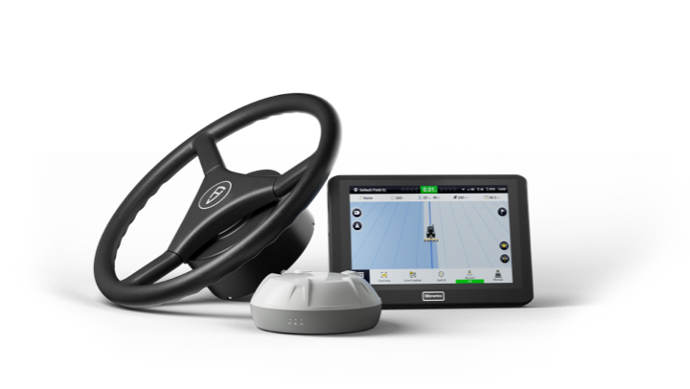If your company is in search of a reliable and efficient autosteering solution for your agricultural equipment, you may have come across the term IMU (Inertial Measurement Unit). It is an advanced sensor and has been built into the FJD AT2 Auto Steer System. As it is rapidly gaining importance in autosteering systems, this article delves into what IMU is and its significance for your farming operations throughout seasons
What IS IMU
At its most basic level, IMU is a type of sensor that measures the vehicle's position and heading in three-dimensional space. It works by detecting changes in acceleration and rotational movement, which are then converted into data that can be used to calculate the vehicle's current location and heading. IMU sensors are typically made up of accelerometers, gyroscopes, and magnetometers that work together to provide precise, real-time data about the vehicle's movement.
 A variety of sensing components are integrated to measure motion and direction
A variety of sensing components are integrated to measure motion and direction
How Does IMU Work
As mentioned earlier, IMU sensors typically consist of accelerometers, gyroscopes, and magnetometers that work together to provide precise, real-time data about the vehicle's movement. Each component plays a crucial role in the functioning of the IMU system.
Accelerometer
Accelerometers are particularly important for measuring linear motion, such as acceleration and deceleration, and are fundamental to any IMU system. Accelerometers measure the changes in acceleration by detecting the movement of a mass within a tiny microchip. When the IMU moves in any direction, the mass in the accelerometer moves in a different direction. This movement generates a force, which is then converted into an electrical signal that is proportional to the acceleration of the IMU. This signal is then processed to determine the location of the IMU.
Improvements in technology have allowed accelerometers to be made smaller and more accurate. Modern accelerometers used in IMUs have become incredibly sophisticated and sensitive, providing real-time and highly accurate measurements of even the slightest movements in all three dimensions.
Gyroscope
A gyroscope is a sensor that measures how fast something is rotating around a particular axis. Unlike an accelerometer, which can sense linear motion, a gyroscope can sense angular motion. Imagine a child on a spinning playground roundabout. As the roundabout spins faster, the child will move outward due to the centrifugal force. But because the child has mass, he or she may resist the force and move a little slower than the roundabout, feeling as though they are being pushed to the side. This concept applies to the gyroscope as well. In a gyroscope, the rotating element resists any attempt to change its heading due to the conservation of angular momentum. This resistance generates a force that is proportional to the rate of rotation, and this force is then converted into an electrical signal, which can be used to calculate the angular velocity of the rotation.
In an IMU, the gyroscope is typically designed using the Micro-Electro-Mechanical Systems (MEMS) technology. A small MEMS gyroscope can be as small as a few millimeters in size, making it an ideal choice for intricate autosteering systems. By measuring the angular velocity around each of the three axes on which the IMU is mounted (roll, pitch, and yaw), the gyroscope can provide highly accurate information about the heading and movement of the autosteering vehicle. Combining the data from both the gyroscope and accelerometer, the IMU sensor has been playing the role of a powerful tool for FJD AT2 Auto Steer System.
Why Is IMU Essential for Autosteering Systems?
IMU is important for autosteering systems because it provides accurate and reliable data about the vehicle's position and heading, even in challenging environments. Combined with GNSS and RTK, IMU enables autosteering systems to navigate through uneven terrain, cross slopes, and other obstacles with greater precision, which leads to improved accuracy and efficiency in seed placement, spraying, and tillage operations. FJD AT2 Auto Steer System, a high-performance autosteering system with built-in IMU in the field of precision agriculture, is able to guarantee a 2.5 cm pass-to-pass accuracy on any terrain. Additionally, IMU can help reduce the operator's fatigue and ensure safety by excluding manual interruption. Such automated steering process would allow operators to focus on other important tasks without incurring a single error during agricultural operations.

IMU Applied to FJD AT2 Auto Steer System
Among tractor autosteering systems for sale, FJD AT2 Auto Steer System, equipped with cutting-edge technologies like GNSS and RTK positioning technologies, has distinguished itself with high cost efficiency and accuracy. IMUs are the most dependable sensors as they cannot be jammed or spoofed and are not affected by weather and other environmental conditions. And thus, supported by built-in IMU devices, apart from real-time positioning with a centimeter-level accuracy, FJD AT2 Auto Steer System is capable of operating despite harsh conditions like high temperatures and complete darkness.
Considering its reliability and adaptability, FJD AT2 Auto Steer System would be an ideal option for various brands of tractors and farm implements.